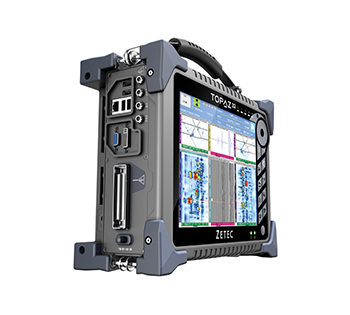What’s the Best Ultrasonic Flaw Detector Price?

When assessing the best ultrasonic flaw detector price, the cost should actually be among the last considerations. Regardless of price, the most efficient ultrasonic testing (UT) instruments can include features such as array inputs, cutting-edge software, and high resolution. And the most important factor when choosing a UT instrument is its ultrasonic reach.
With an excellent UT instrument, users can obtain a more thorough understanding of a weld profile, with no need for excess equipment or multiple testing campaigns. This article will outline why pricing shouldn’t be the main factor when finding ultrasonic flaw detectors.
How to Select the Best Ultrasonic Flaw Detector
There are many UT flaw detectors on the market, but analysts should look for ones that come with benefits such as lightweight portability, ruggedness, and easy handling when moving to various locales. As is the case with many products, you get the quality that you pay for and this is particularly relevant when evaluating the features and dependability of a UT testing instrument.
Instead of using price as a guideline, look for a solution with advanced features that can meet evolving operational needs like strong bipolar pulsers that can help penetrate through thicker sections. Even though the price may be higher, analysts can receive high-quality data that includes more flaws than low-priced UT instruments. A standard UT flaw detector without advanced functionality may cause technicians to miss underlying defects that could cause significant damage.
In addition to field-ready design and dependability, a prime UT device should include the following attributes:
- Phased array ultrasonic testing (PAUT)
- Fully integrated and portable
- 2D matrix array inputs in multiprobe, pitch & catch, or pulse echo
- High resolution
A UT setup that includes phased array options is preferred since PAUT provides flexible configurations that allow analysts to find more flaws during a single testing session. For instance, PAUT fosters multiple scanning angles from a single probe, giving users the ability to find flaws entrenched in awkward positions, such as parallel cracking. Moreover, PAUT offers augmented wave beam and focus depth to achieve better flaw characterization and detection. An instrument with PAUT may be pricier, but you’ll save additional time and money with PAUT campaigns.
UT Matrix Array Additions
A 2D matrix array option is worth the buy, as matrix array capabilities can combat propagation issues stemming from high attenuation. With a low-resolution matrix array, analysts can counter grain reflections found within coarse welds. A conventional flaw detector may lack the means to penetrate through high-grain welds, obscuring signal quality and producing low-quality data.
With matrix array use, however, technicians can probe coarse welds without hassle. Moreover, an instrument with 2D matrix array compatibility will save technicians money in terms of less equipment and no external software. And the use of powerful software can buffer 2D matrix array testing in pitch & catch or pulse echo, with no need for added software.
The inclusion of advanced software in UT instruments can enhance PAUT and matrix array capabilities. Also, integrated software allows for a seamless data-gathering process, dispelling the need for manual data post-processing.
The Importance of Quality Resolution
High resolution can further showcase flaws on a simple interface. Look for a UT device with the latest capabilities:
- Full matrix capture (FMC)
- Total focus method (TFM)
Both features enhance resolution, helping analysts gain deeper insight into all aberrations detected. It’s worth noting that the FMC and TFM aren’t necessary components of a flaw detector, but they’re great assets during flaw-finding missions, crafting a comprehensive profile of spotted defects.
What’s the Best Ultrasonic Flaw Detector Price?
The best ultrasonic flaw detector price isn’t as important as finding quality UT instrumentation that will help technicians pinpoint more flaws in one testing session. Overall, pricing should be a secondary factor when assessing the purchase. Rather, find a UT instrument with a high probability of detection, advanced features, powerful embedded software, and prime resolution attributes. Investing in higher caliber features will ultimately save more money and time during testing campaigns and find more deviations than standard flaw detectors.
When shopping for flaw detectors, low-priced ones can be detrimental to NDT campaigns, as you stand the risk of buying a substandard device that fails to capture flaws. And the safety of people is at stake in industries such as aerospace or manufacturing, in particular, when considering cheap instruments. Instead, quality UT flaw detectors can find early-stage defects, giving maintenance crews more time to commence the necessary repair strategies.
Zetec is a major provider of flaw detector instrumentation that paints a thorough profile of weld integrity. Contact us today to get a custom inspection plan and quality instruments for your NDT needs.

Zetec’s designers are industry-leading experts in ultrasonic and eddy current technologies, and we can help you navigate any of our NDT testing solutions or devices.
